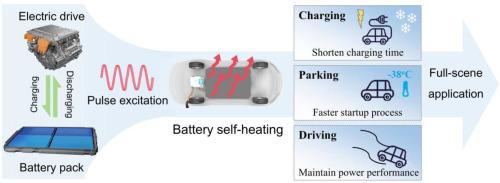Full-scene battery self-heating method based on powertrain system for electric vehicles at extremely low temperatures
IF 17
1区 工程技术
Q1 ENERGY & FUELS
引用次数: 0
Abstract
The popularity of electric vehicles (EVs) in the cold regions is seriously hindered by the degradation of lithium-ion batteries (LIBs) at low temperatures. To settle such issue, it is necessary to preheat the LIBs to moderate temperature for normal operation. As one of attractive internal preheating methods, pulse self-heating possesses high heating rate and efficiency. However, the application of pulse self-heating still faces the challenges of the pulse current power source unavailable in EVs. Herein we proposed a novel battery self-heating method which reuses the powertrain system of EVs to generate pulse excitation onboard, eliminating additional hardware. Moreover, the decoupled control of battery self-heating and motor torque was further developed to achieve the full-scene application, including charging, parking and driving. When applied in EVs, the proposed self-heating method could realize fast temperature rising of battery pack, shortening 30.7 % charging time at −20 °C compared with the conventional heat pump method. It also achieves rapid startup of EVs even at low temperature of −38 °C with high heating rate (0.73 °C min−1) and low energy consumption (4.2 % SOC), as well as maintains the dynamic performance during driving at −30 °C. The proposed method provides a promising solution to preheat the battery pack for EVs application at extremely low temperatures.

基于动力总成系统的电动汽车极低温全场景电池自热方法
锂离子电池的低温降解严重阻碍了电动汽车在寒冷地区的普及。为了解决这个问题,有必要将lib预热到正常工作的温度。脉冲自加热具有较高的加热速率和效率,是一种很有吸引力的内部预热方法。然而,脉冲自加热的应用仍然面临着电动汽车无法获得脉冲电流电源的挑战。在此,我们提出了一种新的电池自加热方法,该方法利用电动汽车的动力总成系统产生车载脉冲激励,消除了额外的硬件。进一步开发电池自热和电机转矩的解耦控制,实现充电、停车、行驶全场景应用。应用于电动汽车时,所提出的自加热方法可以实现电池组的快速升温,与传统热泵方法相比,在−20℃的充电时间缩短了30.7%。在−38℃的低温条件下,也能实现电动汽车的快速启动,加热速率高(0.73℃min−1),能耗低(4.2 % SOC),且在−30℃下仍能保持行驶过程中的动态性能。该方法为在极低温度下对电动汽车电池组进行预热提供了一种很有前景的解决方案。
本文章由计算机程序翻译,如有差异,请以英文原文为准。
求助全文
约1分钟内获得全文
求助全文
来源期刊

Etransportation
Engineering-Automotive Engineering
CiteScore
19.80
自引率
12.60%
发文量
57
审稿时长
39 days
期刊介绍:
eTransportation is a scholarly journal that aims to advance knowledge in the field of electric transportation. It focuses on all modes of transportation that utilize electricity as their primary source of energy, including electric vehicles, trains, ships, and aircraft. The journal covers all stages of research, development, and testing of new technologies, systems, and devices related to electrical transportation.
The journal welcomes the use of simulation and analysis tools at the system, transport, or device level. Its primary emphasis is on the study of the electrical and electronic aspects of transportation systems. However, it also considers research on mechanical parts or subsystems of vehicles if there is a clear interaction with electrical or electronic equipment.
Please note that this journal excludes other aspects such as sociological, political, regulatory, or environmental factors from its scope.
 求助内容:
求助内容: 应助结果提醒方式:
应助结果提醒方式:


